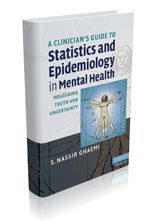A Clinician’s Guide to Statistics and Epidemiology in Mental Health: Measuring Truth and Uncertainty
Is A Clinician’s Guide to Statistics and Epidemiology in Mental Health what we have been waiting for? Yes and no. It contains solid descriptions of concepts such as the P value and confidence intervals, and it has extensive discussions of the history of modern statistical methods. Perhaps its greatest strength involves critiques of the interpretations of several studies that have mistakenly become cornerstones of clinical lore.
Journals, newsletters, national experts, drug reps, the Internet, and patients continually bombard us with new studies demonstrating the effectiveness of a host of treatments for psychiatric disorders. Claims of benefit are generally based on statistical analyses of complex data, and these analyses-usually performed by industry sponsors of the studies-lead to FDA approval and adoption of a therapy into practice guidelines.
When most of us look at the actual studies, we often assume that the data analysis is correct and accept the conclusions. Yet this assumption is not always justified. What we need is a concise and comprehensible road map that will help us understand quickly the statistical assumptions behind the acceptance of the results of clinical trials as facts.
Is A Clinician’s Guide to Statistics and Epidemiology in Mental Healthwhat we have been waiting for? Yes and no. It contains solid descriptions of concepts such as the P value and confidence intervals, and it has extensive discussions of the history of modern statistical methods. Perhaps its greatest strength involves critiques of the interpretations of several studies that have mistakenly become cornerstones of clinical lore.
Considering the amount of material covered, the book is mercifully brief; but confusing cross-references abound that invite the reader to leaf back and forth through different chapters. Basic concepts are applied before they are explained, a teaching approach that will be compatible with some learning styles but not with others. In this particu-lar case, brevity is sometimes-but not always-the soul of clarity. The relationship between statistical and clinical significance, especially when the primary outcome variable is a rating scale score, must be sought out in other texts. Some experts would debate some of the approaches recommended by the author-such as accepting results that are “nearly” significant as clinically important, especially in one’s own research-but this level of debate is not necessary to address in an introductory book.
Anyone who is interested in the philosophy of science will be rewarded by a rich and interesting history of the evolution of statis-tical techniques. Those wanting to learn why it took so long to recognize the association between smoking and lung cancer; why it is necessary to control for multiple confounding variables in medical and especially psychiatric research; or why the more statistical tests are performed, the more stringent the definition of significance has to be will find this book useful. Readers looking for a practical approach by which non-researchers can interpret and apply specific statistical methods or those seeking a step-by-step description of the major fallacies of studies that form the basis of some of our most common treatment approaches will have to look elsewhere.

